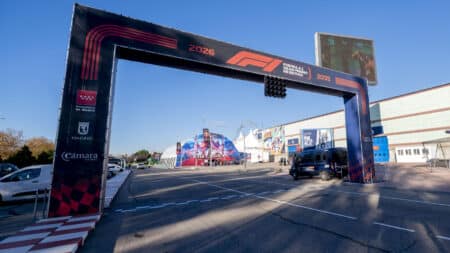
Why isn't 2025 F1 season as close as predicted? The past explains why
McLaren's breakthrough in a near-four-year-old ruleset shows F1 rules convergence is a myth – just like Sebastian Vettel, Red Bull and Renault did in 2013, writes Mark Hughes
It wasn’t the tinny refrain of a mobile phone alarm that fractured slumber, but a boisterous thunderclap. The day’s first serious storm erupted before sunrise and ensured the Sepang International Circuit would be given a good hosing before cars were released for final free practice. Engineering input can radically alter chassis composure… but so can nature.
Lotus hadn’t touched Kimi Räikkönen’s set-up overnight. What was the point? The E21 had been a paragon of balance on Friday, when the Finn set the pace, but during FP3 it oversteered horribly (although he was still an in-touch fifth during the session). As the car remained the same, the answer lay somewhere amid a cocktail of rain and GP2 rubber.
It’s not always simple to pinpoint a problem beyond your immediate control – something that also extends to the FIA: as in Australia, its race control telemetry is not functioning reliably and various automated functions have been disengaged for the weekend’s balance.
Räikkönen thought his car felt slightly better by Q1 (although he would eventually get a three-place grid penalty for impeding Nico Rosberg), but the true performance picture remained masked by circumstance. Sebastian Vettel used the same set of medium Pirellis in Q1 and Q2 – a ploy designed to conserve the harder compound for the race – and only just squeaked through the first bit. “It’s always hard to judge things when you are not pushing 100 per cent,” he said. He thought he might need a second run in Q2, but rain then came to his salvation. Rosberg set the fastest time of the session, 0.25s clear of Mark Webber’s Red Bull, but that counted for nothing. In Q3 Vettel used two sets of intermediates to take pole by more than a second – the 38th of his F1 career, 81 races and little more than four seasons since he annexed his first. The Ferraris of Felipe Massa and Fernando Alonso were second and third, ahead of Lewis Hamilton’s Mercedes and Webber. Jenson Button was eighth for McLaren, but the team reports useful incremental progress since its calamitous weekend in Melbourne.
It is almost certain to rain at some point on raceday, but the moot point is when. “I think we’ll have enough tyres to do a race distance in the dry,” Vettel said, with a grin, “but if it’s wet I guess there’s a chance we might run out…”
Webber was victim of a miscommunication – the chequered flag appeared before he expected it, denying him a final swift lap. “The way things keep changing at this place,” he said, “we really have no idea where we stand. It’s definitely going to be interesting, though.”
Earlier on, the morning had mostly been positive for Britain’s quartet in the opening round of the GP2 Series. James Calado recovered from a slow start (“My tyres weren’t quite up to temperature and I think I was just being a bit too cautious, with it being the first race of the year”) to take second, while Jolyon Palmer stormed through from the back of the field – the consequence of a throttle damper problem in qualifying – to finish sixth. Returnee Sam Bird overcame a drive-through penalty (failure to slow sufficiently when passing a yellow flag) to take seventh, and secure a front-row berth for tomorrow’s sprint, but rookie Adrian Quaife-Hobbs retired after tangling with team-mate Daniel de Jong. The Englishman was subsequently handed a grid penalty for race two, but slips only from 25th to 26th.
Chinese newcomer Ma Qing Hua’s pace deteriorated enormously towards the event’s end, to the extent that he was eventually lapping almost half a minute slower than the leaders. There was nothing wrong with his car, but he was absolutely exhausted and had to be stretchered away and rehydrated after the race. He has been administered assorted supplements and should be able to compete – well, drive around a bit – tomorrow.
Hua symbolises the struggle many GP2 teams face to raise operational budgets. He has a mediocre single-seater record, but access to pots of cash: he scored a class win in the Chinese Touring Car Championship before last year paying his way into a reserve F1 role with HRT. The Spanish team hoped his presence might generate sufficient funding to assist its survival, but it wasn’t to be. He has now acquired a GP2 seat with Caterham – and is soon expected to complete some Friday morning F1 sessions with the team’s senior arm.
It has always been plain that he wasn’t yet fit for purpose, but beyond that it seems he simply isn’t fit, either.

McLaren's breakthrough in a near-four-year-old ruleset shows F1 rules convergence is a myth – just like Sebastian Vettel, Red Bull and Renault did in 2013, writes Mark Hughes

Madrid finally has a consortium to build the new Formula 1 circuit that will host the 2026 Spanish GP

Helmut Marko caused a stir after the Bahrain GP with his worries that Max Verstappen could leave Red Bull early. But how real are those fears?

Ayrton Senna’s tragic final races in 1994, marked by controversy over illegal traction control and his relentless pursuit of excellence in a challenging car, remain a poignant chapter in F1 history, as Matt Bishop recalls